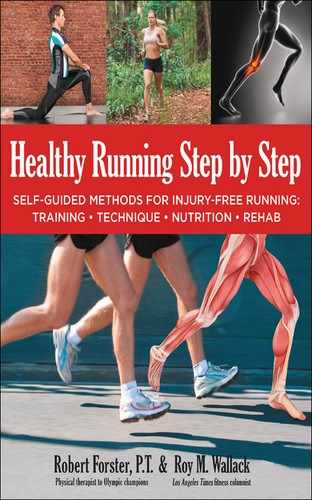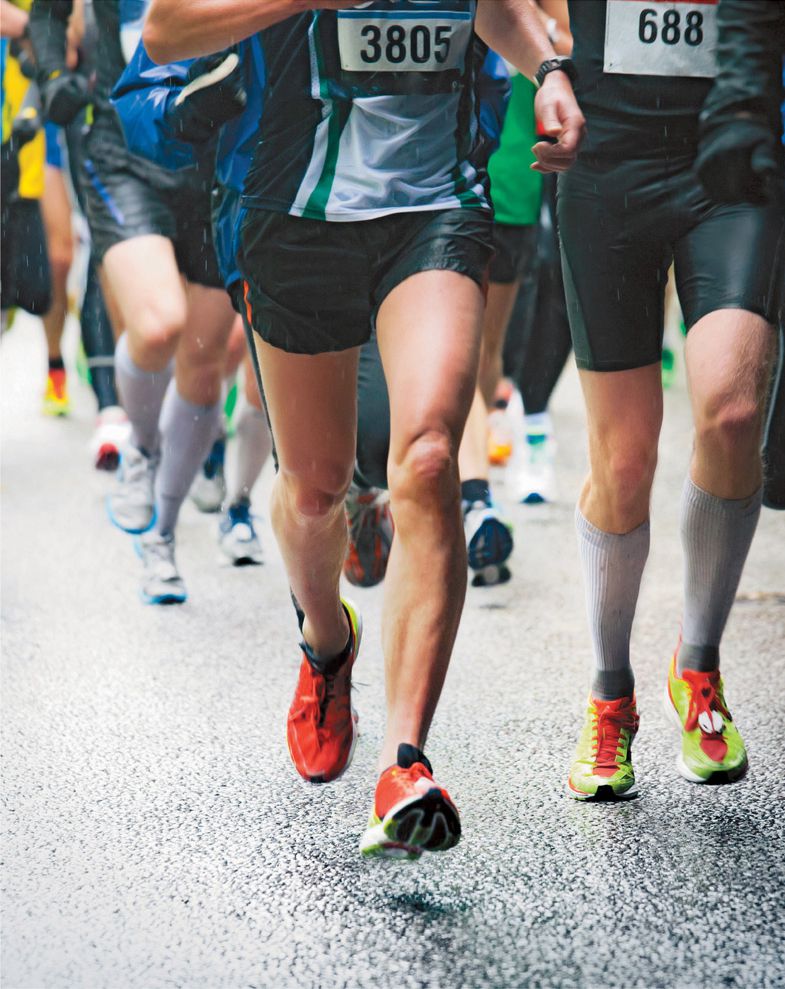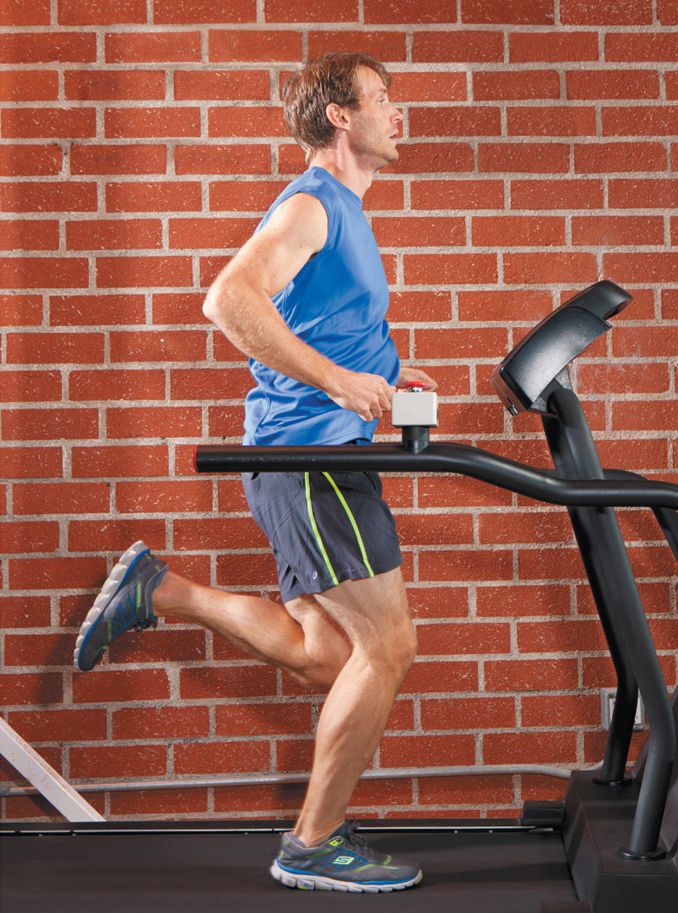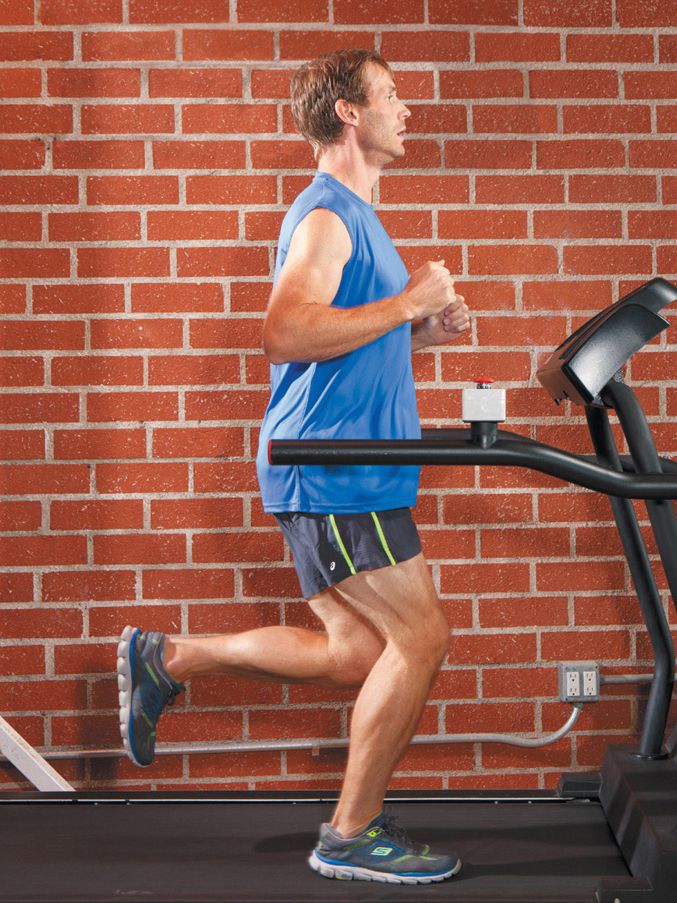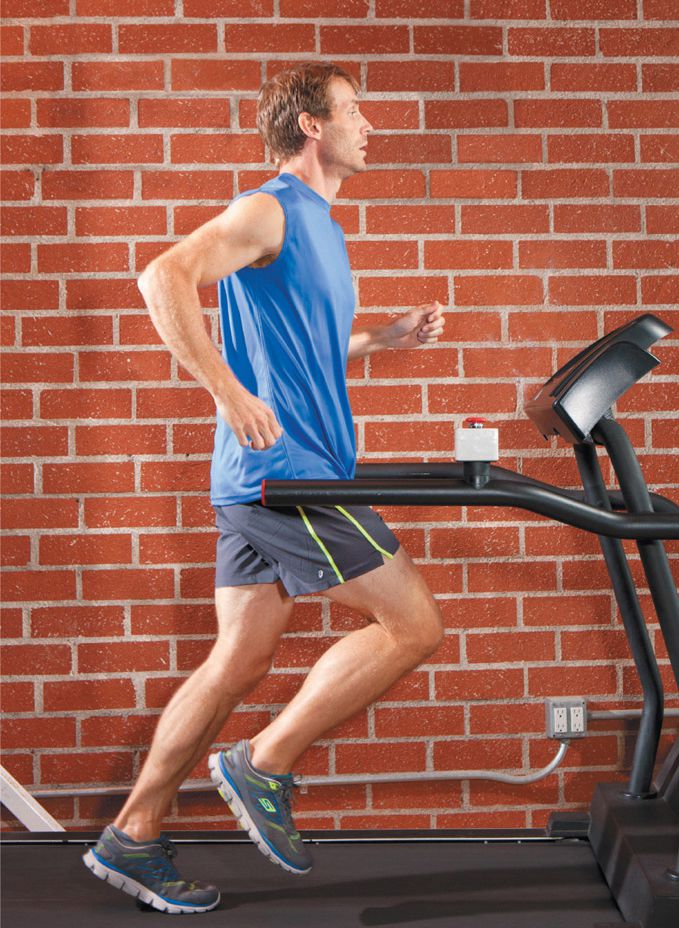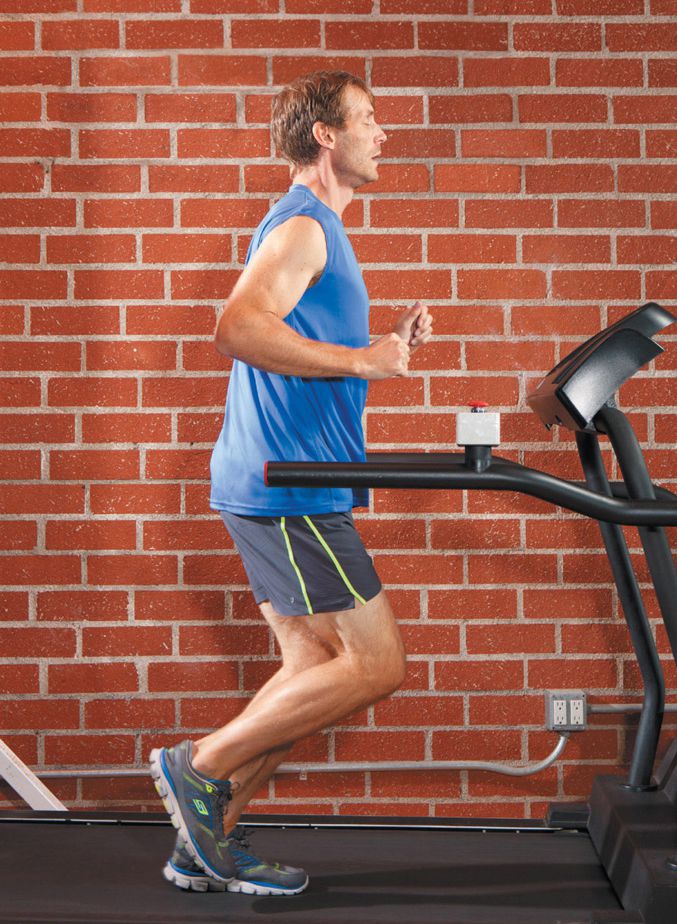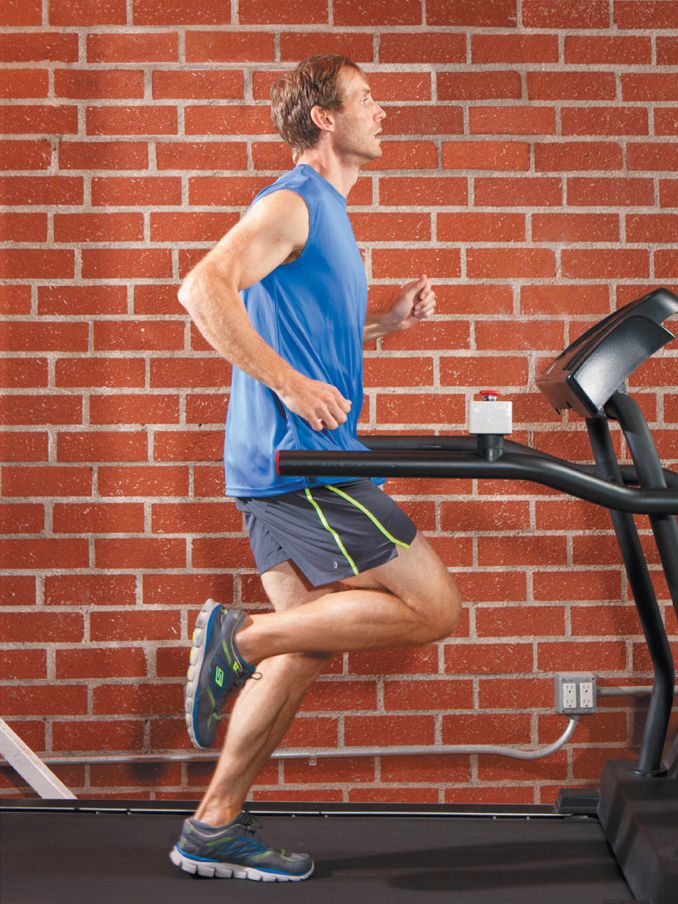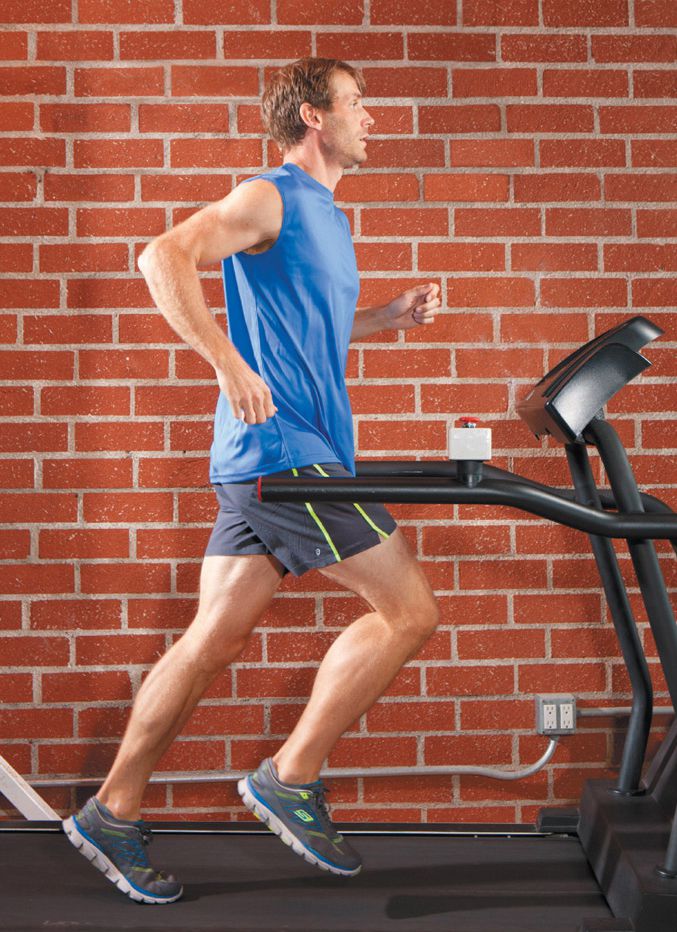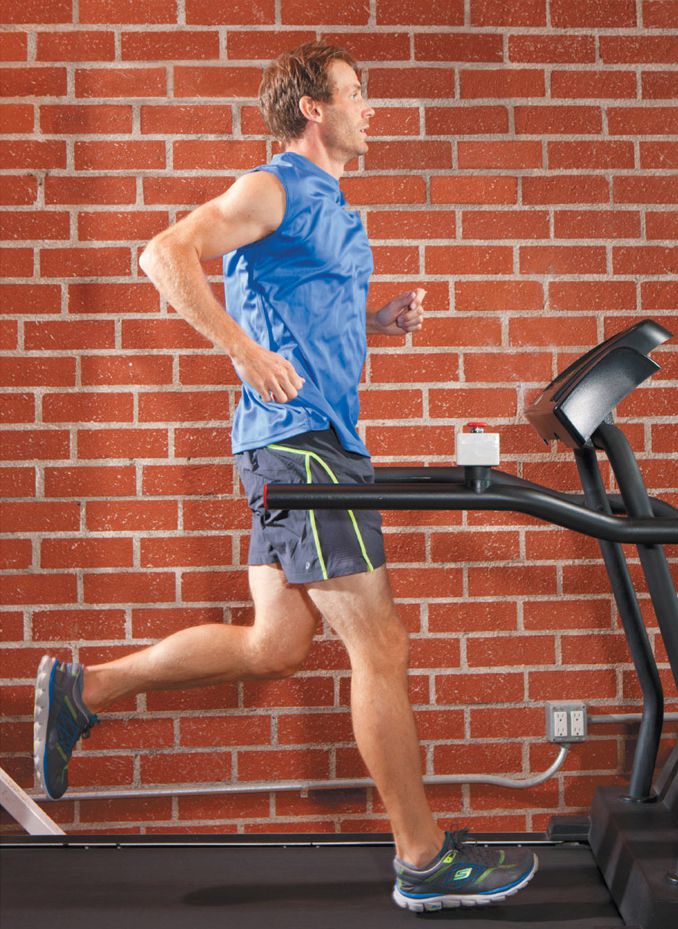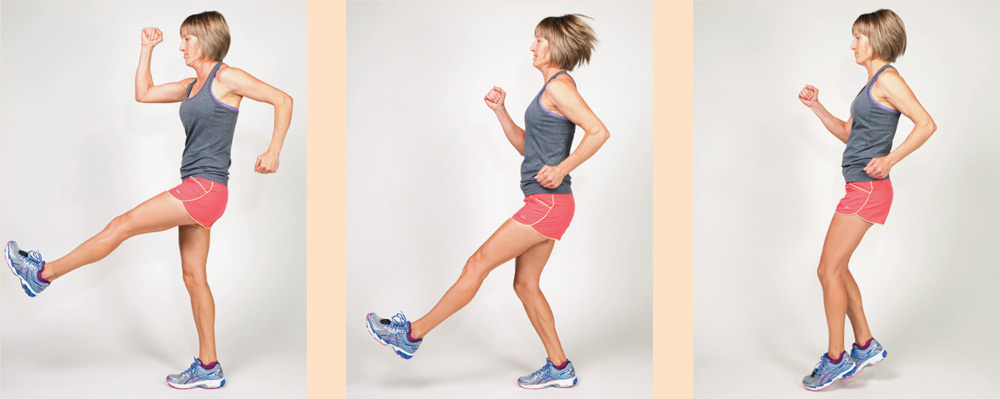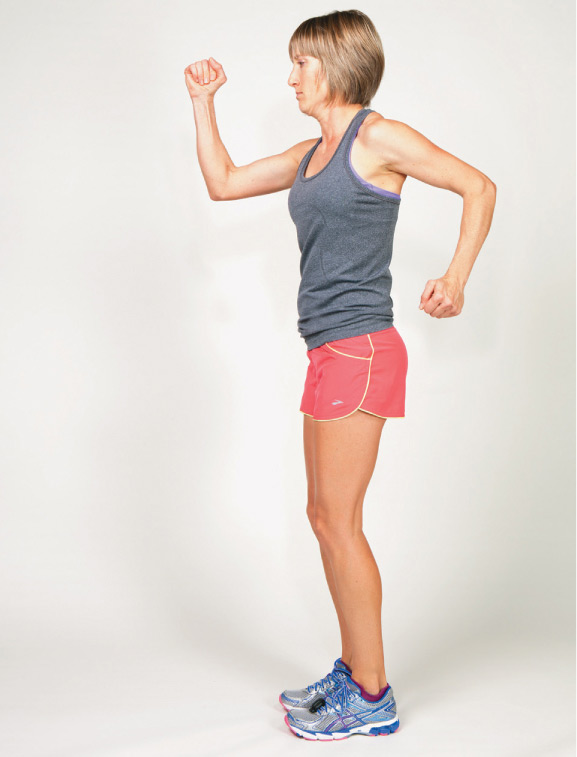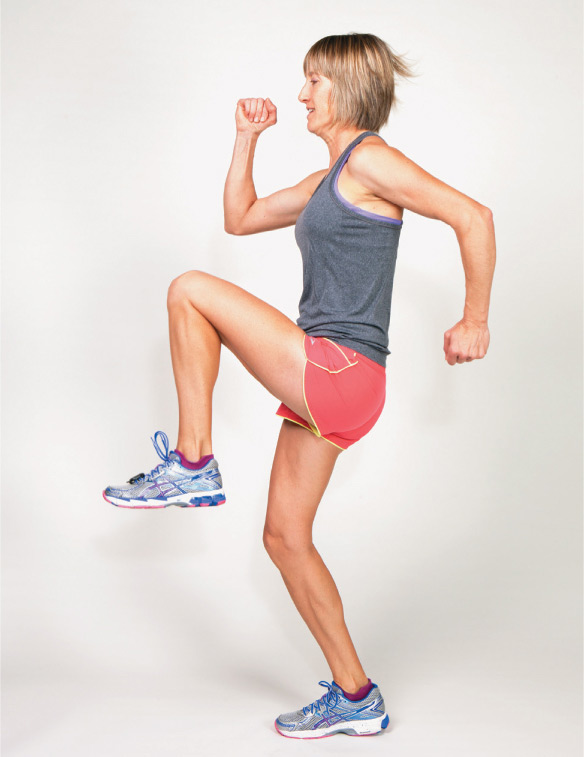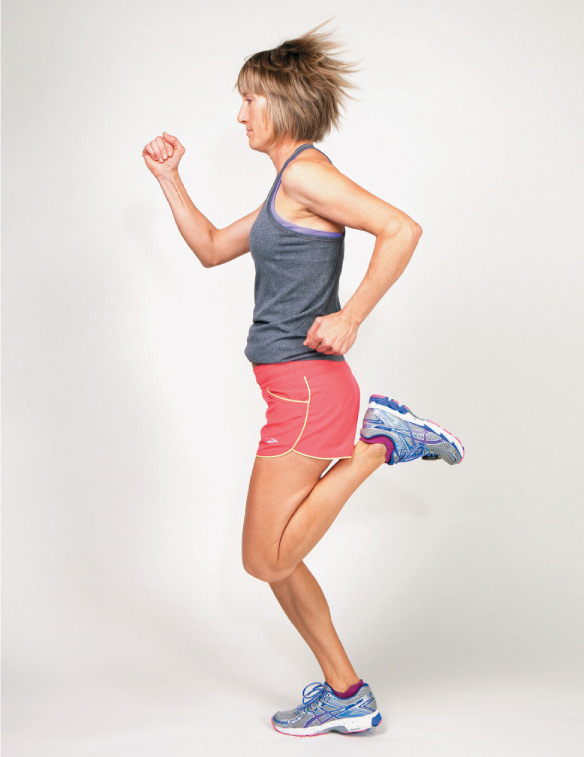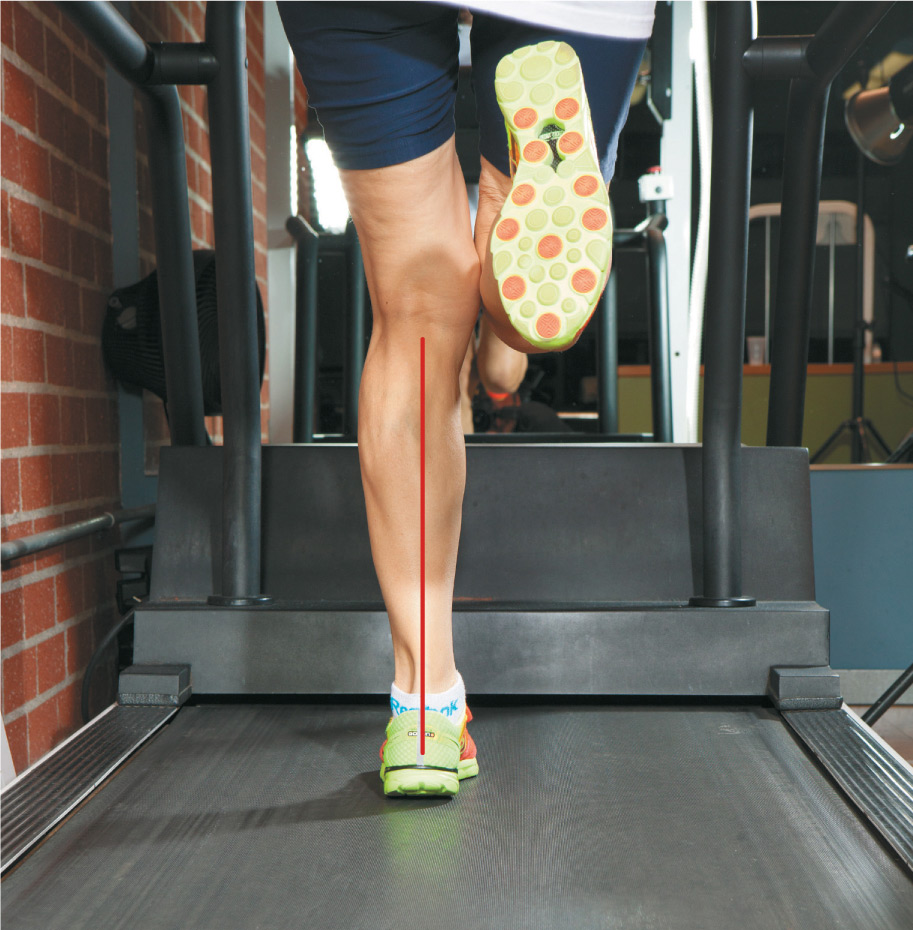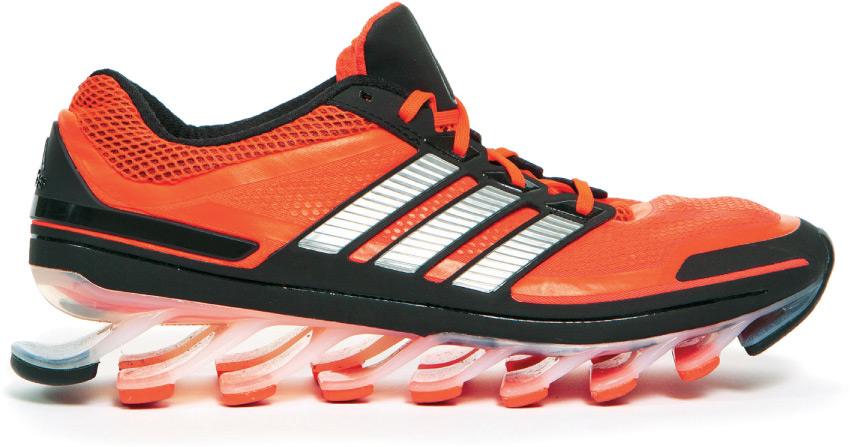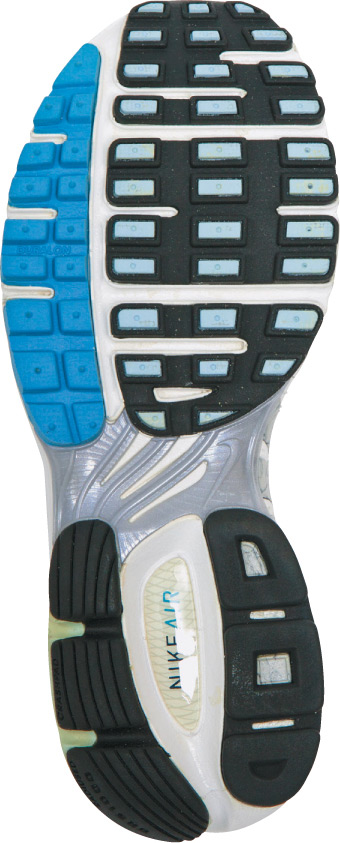2 Technique and Shoes
Three simple form changes will add speed and end the debilitating heel strike.
We humans are movement machines. Evolution built our bodies to run, walk, and stride for long distances at fast speeds, probably to track down animals for dinner—and run from them when they have other ideas. Compared to our slower primate cousins, human bodies have a large number of running-friendly features: shorter arms to balance the cyclic movement of the legs; lighter lower legs and thicker hips, which allow the leg to swing with little effort like a pendulum; bigger, more complex feet, to absorb shock; and thicker lumbar vertebrae, also to absorb greater shock forces. In addition, we have a built-in economy of motion that turns our muscles, tendons, and connective tissue into natural springs, slings, and pendulums that effectively store energy during the gait cycle, then return it on the next step.
Ultimately, it does not matter what type of running shoes you wear as long as you run using proper technique.
So if we are natural runners, why do we so often get hurt doing it?
The trouble is that the sedentary lifestyle of the modern world has basically ruined our ability to exploit our gifts. Unburdened of the need to hunt and chase and carry, we don’t move enough and have become soft. As with everything related to the body, it’s a case of “use it or lose it.” Even though you run 1 hour a day, in the modern world that means your body is lying fallow 23 hours a day. We have become so removed from our natural movement patterns that our bodies are a mess. All that sitting has left our hips tight, our hamstrings and calves shortened, and our glutes weak. Our bodies have forgotten how to move the right way.
To reawaken our distant memories of correct movement, you’ll have to relearn how to do one of the most natural activities: running.
Some people may recoil at that. Learn how to run—when we were born that way? Seems crazy, right? But the reality is that natural running in the modern era is an acquired skill, no different than a beginning golfer taking golf lessons, a tennis novice taking tennis lessons, a rookie guitar player taking guitar lessons.
As far as your corrupted-by-the-modern-world body is concerned, running the way that nature intended actually requires increased strength and new neurological patterns. If you want to run correctly and injury-free, you must drop the notion that because you ran as a kid—or even do a marathon a month now—you already know how to run—and don’t need lessons. Wrong! You know about as much about running as a high school freshman does about throwing a javelin for the first time. He knows how to throw a stick, but it’s not going to go very far without learning the specifics of good technique. But it isn’t difficult. In fact, with a few simple cues and a basic understanding of physics, you can take advantage of the evolutionary gifts bestowed upon you to run efficiently and injury-free.
Those who have studied running techniques even briefly have most likely heard of the Chi Running, Pose, and barefoot running methods, which as a group share a bias against the heel strike—with which I don’t disagree. People were not designed to land on their heels. The heel strike gives you a “braking” effect—that is, it slows you down—and a potential “breaking” effect—meaning that it transmits far too much shock up your leg and into your knee, hip, and spinal joints and can lead to injury.
Does this mean that I’m completely in sync with Chi, Pose, and barefoot advocates? Not necessarily. I think they tend to make running more complicated than it needs to be and don’t fully understand how to exploit all of the built-in efficiencies of the human body. My approach to proper running technique focuses on what happens to the leg at the joints of the pelvis, hip, and knee, and where your foot hits the ground in reference to your center of gravity. When you use these joints properly, the foot strike takes care of itself.
The Three Big Changes
I can change a runner’s gait for the better in 6 minutes. And you can, too. If you read this section and go out and practice these three specific changes, your gait and performance will improve immediately and you will spare yourself most of the common running injuries.
To develop a deeper understanding, continue reading past this section and delve into the physics involved. Time and time again at my Phase IV Scientific Health & Performance Center, a private training center with an exercise physiology lab attached that I opened in 2003 to bring science-based training to age-group athletes, we’ll put runners on the treadmill, videotape their normal running style, and coach them into better mechanics. When they see their videotaped change in form, it never ceases to leave them astounded—especially because we’ve only asked them to do three relatively simple things:
• Adopt a vertical arm swing.
• Adopt a vertical arm swing.
• Lift their knees a little higher.
• Speed up their cadence.
Here’s why these three things work:
1. Adopt a vertical arm swing.
If you correct your arm swing, you’ll balance your body, eliminate misdirected motion and excessive torque on joints, and run faster. Every action creates a reaction is a basic law of physics that holds true for your body when running. When something on the left side of the body moves, there has to be a counterbalancing movement on the right side in order to remain upright and balanced. The ideal counterbalance from a pure energy-cost point of view is one that will take the least amount of effort. So, when the right leg swings forward and the resulting forces want to rotate your trunk and shoulders to the left, you could flex the muscles of the midsection (your abs and lower back) to keep you in balance—but that has a high energy cost. The lowest energy cost would be to leave the midsection alone and simply swing your left arm straight forward to prevent your trunk from rotating. And the most economical way to swing the arm is like a pendulum.
The arm should move like a pendulum anchored at the shoulder, with the weight of the hand acting to keep the pendulum swinging. To be most efficient, this pendulum arm swing must have two features: first, a vertical arc that does not angle crosswise over your chest. This arc directs all your effort to moving forward, eliminating the side-to-side body rotation that costs you a lot of energy, slows you down, and puts extra stress and wear on your joints. Second, the arm should have an ideal bend slightly more open than a 90-degree right angle. This bend allows the weight of the hand to swing the arm like a pendulum, which is more energy efficient than balancing the leg motion with the trunk muscles.
In helping the arm pendulum swing better, the backswing is often ignored. Although it might seem easy to push your elbows back a couple of inches behind the plane of your back (which then lets your arms easily swing forward), many people can’t do it. That’s because of tight pecs, which you get from too many push-ups and bench presses and sitting scrunched up at a desk all day. Many runners are too tight to achieve adequate backswing, and this reduces the arm’s tendency to move back and forth like a pendulum. So to develop a good backswing, we have to stretch the pectorals.
2. Lift your knees a little higher.
Most runners have inadequate front knee lift, which is usually because of weak hip flexors and core, and tight glutes and hamstrings. The low lift penalizes them with the most common inefficiency in running: landing with the lower leg still swinging forward when it hits the ground, leading to a significant braking effect on their forward momentum.
To minimize this effect, the lower leg and foot must actually be moving backward when the foot strikes the ground. This is made possible by a high knee lift, accomplished by hip flexion of at least 40 to 50 degrees, which gives the lower leg enough time to finish swinging forward and then begin moving backward before the foot strike. Technically, what’s happening here is that the leg has enough height and time to swing, pendulum-like, back to the center while the elasticity of the hamstrings’ and glutes’ connective tissues snaps the leg back. The result: no braking effect—your foot is traveling backward as it lands below your center of gravity.
Bad form: low knee rise, which also results in a low heel rise in back and heel strike while the leg is still swinging forward.
Good form: high knee rise created by the hip flexing to at least 45 degrees, heel rises naturally toward the butt.
3. Speed up your cadence.
Long, slow strides thrust a straight leg out ahead of your body, making it impossible not to land on your heel or under your center of gravity. Every millimeter that your foot hits the ground in front of your center of gravity increases the braking effect on your forward momentum. The solution is simple: Increase your turnover. Run shorter strides with faster turnover. Because stride frequency and stride length are inversely related, the more steps you take per minute the shorter each step will be and the closer you will land beneath your center of gravity.
To be efficient, improve performance, and dramatically reduce your chance of getting injured, take 180 steps per minute (30 steps every 10 seconds), regardless of your speed. You’ll benefit from increased cadence in several ways, whether you’re a 10-minute miler or a 6-minute miler.
First, and most important, a fast cadence minimizes the braking effect, thereby reducing the overall energy required to maintain your pace. Second, shorter steps break up the workload into smaller chunks, which allow your muscles to make a less intense, more aerobic effort that keeps you in a greater fat-burning mode.
Be aware that the higher knee lift and faster cadence will seem harder at first. That’s because that you, as a modern human, are starting in a weakened state. Initially, you won’t have the strength to lift the knee high and turn your legs over swiftly. This is where the strength and flexibility exercises in chapters 7 and 8 come in. They will create your ability to exploit the built-in efficiency that nature intended.
STRIDE-CHANGING TRAINING DRILLS
The best way to work into this more efficient higher cadence running technique is to practice on a treadmill, which allows you to see the seconds go by and count your steps. Also, treadmill running is less taxing, because the ground is moving under you and all you have to do is really launch yourself in the air and then land, reducing the energy expenditure of running.
Begin with a 10-minute warm-up at your normal training pace. Without increasing the speed of the treadmill, practice a mix of your new faster/shorter and your old slower/longer strides. Start off with 2 minutes at a faster cadence, gradually building up to 30 steps every 10 seconds. Every foot strike, right and left, counts as one step. If you are like nearly every runner I have evaluated over the past 30 years, you will be taking about 25 or 26 steps per 10 seconds. The 4- or 5-step deficit does not seem like much of a problem, but it is. Per minute it adds up to 25 fewer steps, per mile it represents hundreds of inefficient steps, and thousands over the course of a 10k or longer.
At first, after 2 minutes of the faster cadence, you will be breathing harder and getting fatigued, so go back to your old lumbering gait and recover for 3 minutes. Repeat this for the duration of your workout and then build up to 3 minutes on/2 minutes off, and 4 on/1 off over the coming weeks. Soon, you’ll have the strength to keep up the efficient high stride count and harvest the energy savings of running with the laws of physics, instead of fighting them. In addition to working on a faster cadence, there are four drills that will facilitate proper running mechanics: arm swing, high knee, butt kick, and Cossack, described in “Running Mechanics Drills” on pages 34–35. Do 2 reps of these drills each for 30 seconds after you have warmed up, twice per week.
Running with the Laws of Physics
To fully understand the whys of proper running mechanics and how to use your body correctly when running, we have to talk a little about a few simple laws of physics:
MOMENTUM
A body in motion tends to stay in motion unless some force acts to impede its progress. Every time your foot hits the ground, the foot-ground reaction acts to slow you down. Every millimeter that your foot strikes the ground in front of your center of gravity further increases the braking effect on your forward momentum. The center of gravity of your body is the center of your weight distribution, the point where your body would teeter on a focal point if you were lying horizontal in space. This spot is located in the back of the pelvis. Left to our own devices, all of us overstride—that is, land way too far in front of a line dropped from the center of gravity to the ground below us. This not only wastes energy as we try to regain forward momentum, but it causes us to land on the heel of the outstretched leg and leads to injury from the excessive shock forces. So when it comes to foot strike, it is not which part of your foot hits the ground first, it’s where your foot hits the ground in relationship to your center of gravity that will either minimize ground reaction or amplify it—that is, either slow you down or let you move forward more easily with less effort. A higher knee rise and shorter steps ensure that your foot will hit the ground more directly under your hips.
SLINGS AND SPRINGS
The human body is made of sinewy connective tissues that stretch under the load of our body weight when we hit the ground. The stretched tissues store what is called potential energy; just like a rubber band that snaps back to its original form, the rebounding tendons, ligaments, and fascia give back that stored energy and provide much of the forces needed to propel us forward. If we use our body in the right way, these rebounding tissues can unburden the muscles of some of the work and save energy, allowing you to run farther and faster. You harness this elastic energy by keeping your connective tissues flexible and running with high knees to keep the leg swinging backward when it hits the ground.
PENDULUMS
A pendulum is a line, weighted at the bottom, which swings in an arc from a fixed anchor point above. It requires very little energy at the beginning of the movement to stay in motion. The most efficient way for the extremities to swing through the air is for them to act like pendulums. Pendulums require gravity to keep them moving because when they swing forward, they hold stored potential energy because gravity wants to swing them back to the bottom of the arc. With little muscular energy at the start of the arm and leg swing, your extremities will return to their place of origin and save muscle energy.
Using a high knee in running serves several purposes. First, it allows us the time needed to be sure the pendulum has finished its forward swing and is moving backward when your foot hits the ground. Second, a high knee rise automatically brings your heel closer to your butt and shortens the length of the pendulum that is your leg. Shortening the swinging lever reduces the energy needed to swing it through the air and therefore reduces the work your hip flexors need to do to pull your leg forward. Last, a high knee rise and the lower leg naturally pulled up closer to your butt reduces wind resistance. It is not only beneficial when there is a headwind, but even on a calm day your body has to push itself through the standing air, and this energy savings adds up over longer distances.
Shoes: Form Trumps Cushioning
I am no advocate of barefoot running, which in practice can cause far too many injuries, especially to foot bones, Achilles tendons, and calves not used to the new biomechanics. That, and the basic lack of protection for the bottom of the foot, is why the enthusiasm for barefooting faded away after the book Born to Run gave it a brief boost starting in 2009. So you have to wear shoes. But what kind? Shoes aren’t perfect, either, because many were designed imperfectly from the start and built on the premise that overstriding is normal.
The shoe companies chased the natural tendency of untrained runners to overstride and heel strike, and actually made it worse. The big, clunky pillow of heel cushioning that has progressed in size over the years to accommodate bad form gets in the way of you pulling your leg backward to land under your center of gravity and prevents you from landing more toward your midfoot. This design makes it harder to clear the ground when you try to pull your foot back. The giant heel pads and the rear-shoe rise that go with it are unnecessary and unwieldy.
Does this mean I advocate flat, low-profile “minimalist” shoes? Well, despite not being a fan of the superskimpy ones, I ultimately think it does not matter what shoes you wear, as long as you run correctly. Runners who run with good mechanics don’t need artificial shock absorption between the ground and their feet, because the natural “slings and springs” of good technique will take care of that. With good technique, your joints perform the shock absorption. A firm sole and adequate heel counter is all most people need for protection, because the reduced ground contact of the faster cadence means you’re not on the ground long enough to overpronate (see “What Is Overpronation?” on pages 36–37), thereby cutting the risk of injuries.
That said, we’re tender-footers. As mentioned previously, I see a host of maladies resulting from going barefoot or wearing minimalist shoes, including plantar fasciitis, bone bruises, stress fractures, and strained tendons.
There are two groups that, even after fixing their running technique, often still have a tendency to experience injuries: Extreme overpronators and heavy people (which can include overweight people or anyone, even very fit, weighing more than 200 pounds [90.7 kg]). If their problems persist, they need bona fide motion control shoes.
Overpronators need shoes with more stability, especially in the form of a rigid heel cup to keep the heel from flopping inward at foot strike. Because overpronation is an energy suck, as you are pushing off from an unstable foot instead of a stable one, motion control shoes will also make their wearers faster.
By the same token, heavy folks just need more shoe—with a denser midsole and heel counter, usually a motion control shoe—because they pound the ground with more force due to their bulk. Whereas a lighter person can mostly rely on technique to absorb shock and let the shoe do the rest in a 70:30 ratio, that ratio will be more like 50:50 for a heavy person.
SUMMARY
To prevent injuries and increase speed, runners must eliminate the heel strike and the overstriding that causes it. Humans, hindered by bodies weakened by modern life and thickly cushioned running shoes, can reestablish their old movement patterns by focusing on three areas: the vertical arm swing, high knee raise, and rapid cadence of 180 steps per minute.
